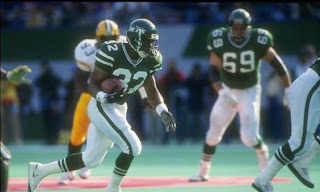 |
| Kevan Barlow |
Anthony Johnson played on the Notre Dame squads that kept me distracted while I lost my way as a Jets fan at college. He would join the Jets, though, in 1994, after having a less than stellar career with Indianapolis, who had drafted him in 1990. He gained 12 yards for the Jets in #32. Three seasons later he would gain more than 1,000 yards for Carolina. Then his career would mysteriously taper off once again. It makes me suspicious in ways that all sports fans must be these days, except that the gods of Wiki say that today he is the Panthers' official chaplain. So there you go. In assessing the veracity of professional athletic performance, perhaps we have to cling to such things.
 |
| Leon Washington |
Eight is always a magic number in the modern game of American football. Since most teams in the game are struggling to do better than break even, all fans feel a little grateful if their team can win at least eight games, even if they are a little disappointed all the same. Each conference in the NFL fields 16 teams. This past season, eight teams in each conference won eight games or less (here I include the Jets' disappointing 9-7 mark with this group, even if it means they're lopped in with the 0-16 Lions). Statistically, I guess that this makes sense. There is parity in this league. I mention all of this as a prelude to talking about #32 Darrien Johnson because all there is to discuss about his career are eight games at defensive back for the Jets, during which he managed one tackle. Eight games in 2005 were all the Jets needed to assess him, and then he was gone from the team and the game. Eight can tell you a lot, I guess.
I suppose someone had to wear #32 during the Kotite years. Or not. Does it really matter? Sherriden May had to play for the Jets at running back at this time, and perhaps his number was merely a coincidence. Did he wear that number at the University of Idaho? Fate picks you, sometimes even by the number. Sherridan May could have worn any number other than #32, but what's more important here is that he was destined to play at running back for the the Jets in their two worst seasons (with all due respect to '75-'76). His number therefore becomes irrelevant. His statistics are so underwhelming as to not be believed, except that the Jets themselves when a jaw-dropping 4-28 from 1995-96. Nothing could have made his seasons better - not a number, not a different position. As the late Billy Preston made abundantly clear, nothing from nothing leaves nothing.
According to Jets' records, Stacy Tutt wore #32 in his work with the Jets from 2006-07, but it's funny how his pictures come up in #45. I think I remember him in #45. It just means that I don't pay attention as I should. It doesn't matter. He has recently been hired as a tight ends coach with his alma mater, the Spiders of the University of Richmond, where he once quarterbacked. I'd like to see a comprehensive list of Jets players who were once the QB stars at their college, only to see limited action at other less glorious positions.
 |
| Blair Thomas |
No comments:
Post a Comment